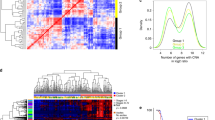Abstract
High-grade serous ovarian carcinoma (HGSOC) is characterised by significant spatial and temporal heterogeneity, typically manifesting at an advanced metastatic stage. A major challenge in treating advanced HGSOC is effectively monitoring localised change in tumour burden across multiple sites during neoadjuvant chemotherapy (NACT) and predicting long-term pathological response and overall patient survival. In this work, we propose a self-supervised deformable image registration algorithm that utilises a general-purpose image encoder for image feature extraction to co-register contrast-enhanced computerised tomography scan images acquired before and after neoadjuvant chemotherapy. This approach addresses challenges posed by highly complex tumour deformations and longitudinal lesion matching during treatment. Localised tumour changes are calculated using the Jacobian determinant maps of the registration deformation at multiple disease sites and their macroscopic areas, including hypo-dense (i.e., cystic/necrotic), hyper-dense (i.e., calcified), and intermediate density (i.e., soft tissue) portions. A series of experiments is conducted to understand the role of a general-purpose image encoder and its application in quantifying change in tumour burden during neoadjuvant chemotherapy in HGSOC. This work is the first to demonstrate the feasibility of a self-supervised image registration approach in quantifying NACT-induced localised tumour changes across the whole disease burden of patients with complex multi-site HGSOC, which could be used as a potential marker for ovarian cancer patient’s long-term pathological response and survival.
Access this chapter
Tax calculation will be finalised at checkout
Purchases are for personal use only
Similar content being viewed by others
References
Vergote, Ignace, et al. “Neoadjuvant chemotherapy or primary surgery in stage IIIC or IV ovarian cancer.” New England Journal of Medicine 363.10 (2010): 943-953.
Kehoe, Sean, et al. “Primary chemotherapy versus primary surgery for newly diagnosed advanced ovarian cancer (CHORUS): an open-label, randomised, controlled, non-inferiority trial.” The Lancet 386.9990 (2015): 249-257.
Morgan, Robert D., et al. “Objective responses to first-line neoadjuvant carboplatin-paclitaxel regimens for ovarian, fallopian tube, or primary peritoneal carcinoma (ICON8): post-hoc exploratory analysis of a randomised, phase 3 trial.” The Lancet Oncology 22.2 (2021): 277-288.
Crispin-Ortuzar, Mireia, et al. “Integrated radiogenomics models predict response to neoadjuvant chemotherapy in high grade serous ovarian cancer.” Nature communications 14.1 (2023): 6756.
Zhang, Hang, et al. “An unsupervised convolutional LSTM network (C-LSTMNet) for lung 4D-CT registration.” IEEE Access (2024).
Tahmasebi, Nazanin, et al. “Real-time lung tumor tracking using a CUDA enabled nonrigid registration algorithm for MRI.” IEEE journal of translational engineering in health and medicine 8 (2020): 1-8.
Xue, Peng, et al. “Structure-aware registration network for liver DCE-CT images.” IEEE Journal of Biomedical and Health Informatics (2024).
Pham, Xuan Loc, et al. “Multi-resolution Coarse-to-fine Registration Approach for Liver Computed Tomography Image Analysis.” 2022 26th International Computer Science and Engineering Conference (ICSEC). IEEE, 2022.
van Garderen, Karin A., et al. “Evaluating the predictive value of glioma growth models for low-grade glioma after tumor resection.” IEEE Transactions on Medical Imaging (2023).
Dupuy, Tamara, et al. “2D/3D deep registration along trajectories with spatiotemporal context: Application to prostate biopsy navigation.” IEEE Transactions on Biomedical Engineering (2023).
Dupuy, Tamara, et al. “2D/3D deep registration along trajectories with spatiotemporal context: Application to prostate biopsy navigation.” IEEE Transactions on Biomedical Engineering (2023).
Huang, Bin, et al. “3D lightweight network for simultaneous registration and segmentation of organs-at-risk in CT images of head and neck cancer.” IEEE Transactions on Medical Imaging 41.4 (2021): 951-964.
Tian, Lin, et al. “GradICON: Approximate diffeomorphisms via gradient inverse consistency.” Proceedings of the IEEE/CVF Conference on Computer Vision and Pattern Recognition. 2023.
Tian, Lin, et al. “uniGradICON: A Foundation Model for Medical Image Registration.” arXiv preprint arXiv:2403.05780 (2024).
Rundo, Leonardo, et al. “Tissue-specific and interpretable sub-segmentation of whole tumour burden on CT images by unsupervised fuzzy clustering.” Computers in biology and medicine 120 (2020): 103751.
Wasserthal, Jakob, et al. “Totalsegmentator: Robust segmentation of 104 anatomic structures in ct images.” Radiology: Artificial Intelligence 5.5 (2023).
Modat, M., Ridgway, G.R., Taylor, Z.A., Lehmann, M., Barnes, J., Hawkes, D.J., et al.: Fast free-form deformation using graphics processing units. Computer methods and programs in biomedicine 98(3), 278-284 (2010)
Balakrishnan, Guha, et al. “Voxelmorph: a learning framework for deformable medical image registration.” IEEE transactions on medical imaging 38.8 (2019): 1788-1800.
Leow, Alex D., et al. “Statistical properties of Jacobian maps and the realization of unbiased large-deformation nonlinear image registration.” IEEE transactions on medical imaging 26.6 (2007): 822-832.
Acknowledgements
We acknowledge funding and support from Cancer Research UK (A22905) and the Cancer Research UK Cambridge Centre [CTRQQR-2021-100012 and A25177], The Mark Foundation for Cancer Research [RG95043], GE HealthCare, and the CRUK National Cancer Imaging Translational Accelerator (NCITA) [A27066]. Additional support was provided by the National Institute for Health Research (NIHR) Cambridge Biomedical Research Centre [NIHR203312 and BRC-1215-20014] and the EPSRC Tier-2 capital grant [EP/T022221/1]. This work was further supported by the backing of the Federal Ministry of Education and Research (BMBF, Grant Nos. 01ZZ2315B and 01KX2021), the Bavarian Cancer Research Center (BZKF, Lighthouse AI and Bioinformatics), and the German Cancer Consortium (DKTK, Joint Imaging Platform). Further support was received through the St. Baldrick’s Career Development Grant, NIH R61NS126792, NIH R21TR004265, and NIH R21NS21735. Additionally, we recognize the contribution of the Helmholtz Information and Data Science Academy. The authors would like to acknowledge the support of the Scientific Computing team from the Cancer Research UK Cambridge Institute.
Author information
Authors and Affiliations
Corresponding author
Editor information
Editors and Affiliations
Ethics declarations
Disclosure of Interests
The authors have no competing interests to declare that are relevant to the content of this article.
Rights and permissions
Copyright information
© 2024 The Author(s), under exclusive license to Springer Nature Switzerland AG
About this paper
Cite this paper
Machado, I.P. et al. (2024). A Self-supervised Image Registration Approach for Measuring Local Response Patterns in Metastatic Ovarian Cancer. In: Modat, M., Simpson, I., Špiclin, Ž., Bastiaansen, W., Hering, A., Mok, T.C.W. (eds) Biomedical Image Registration. WBIR 2024. Lecture Notes in Computer Science, vol 15249. Springer, Cham. https://doi.org/10.1007/978-3-031-73480-9_23
Download citation
DOI: https://doi.org/10.1007/978-3-031-73480-9_23
Published:
Publisher Name: Springer, Cham
Print ISBN: 978-3-031-73479-3
Online ISBN: 978-3-031-73480-9
eBook Packages: Computer ScienceComputer Science (R0)





